|
 Gliophorus ostrinus Gliophorus ostrinus
SynonymsHygrocybe ostrina
BiostatusPresent in region - Indigenous. Endemic
Images (click to enlarge)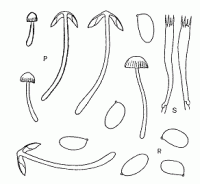
Caption: Fig. 37 Gliophorus ostrinus Horak (P-S: PDD 27228, type): P.
basidiomes. R. spores. S. basidia. | 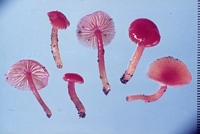
Owner: Herb PDD | 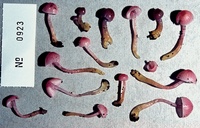
Caption: ZT0923 , Holotype
Owner: E. Horak: © Creative Commons Attribution-Noncommercial 3.0 New Zealand | 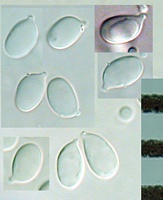
Owner: J.A. Cooper | 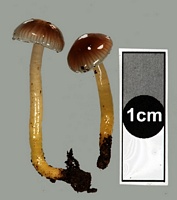
Owner: J.A. Cooper | 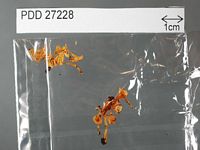
Caption: Dried type specimen
Owner: Herb PDD |
Article: Horak, E. (1990). Monograph of the New Zealand Hygrophoraceae (Agaricales). New Zealand Journal of Botany 28(3): 255-306 (http://www.rsnz.org/publish/abstracts.php).
Description: Pileus - l 5 mm, hemispherical when young becoming convex with low umbo in
centre, finally subcampanulate; brilliant purple turning lilac to pink with
age;: glutinous, translucently striate at margin, membranaceous. - Lamellae
8-12 (1-3) emarginate-adnexed to almost free, ventricose, up to 3 mm wide; whitish,
with pale lilac tint in aged basidiomes, edges concolorous, entire, glutinous
thread absent. - Stipe 10- 50 x 1.5-3 mm, cylindrical, equal or gradually attenuated
towards apex; concolorous with pileus in, upper half (but pink in aged specimens)
turning yellow towards base; glutinous, fistulose, brittle, single or caespitose.
- Context purple-lilac in apex of stipe changing to pink, yellow in base of
stipe, waxy. -. Odour and taste not distinctive. - Chemical reactions on pileus:
KOH - negative. - Spore print white.
Spores 5.5 6.5 x 34 um, elliptical, smooth, hyaline, inamyloid.-Basidia 30-35
x 4 um,4-spored. - Cheilo- and pleurocystidia absent - Pileipellis an, ixocutis
of interwoven, cylindrical hyphae (1-4 um diam.), with round, unbranched tips,
hyaline membrane thin-walled, gelatinised, pigment plasmatic; clamp connections
present (Pl. 1, Fig. 6).
Habitat: ECOLOGY: Rare; saprobic on soil among moss and litter in broadleaved forests,
June.
Distribution: DISTRIBUTION: NZ (NA,LBI).
Notes: ETYMOLOGY: ostrinus = purple.
The present knowledge of G. ostrinus is based upon a single collection
with numerous basidiomes found in the ecologically unique rainforest near the
top of Mt Hauturu on Little Barrier Island. Its slender and fragile basidiomes
recall G. lilacinoides (Horak) in habit and colour. However, the two
closely related taxa can be distinguished in particular by their spore size
and the distinctive colour changes caused both by ageing and/or leaching of
the basidiomes. Another distinguishing feature is the morphology of the terminal
cells in the ixocutis. In G. ostrinus the terminal cells on the gelatinised
hyphae are not differentiated at the tips whereas in G. lilacinoides
the terminal cells are constantly found to be subfusoid. In addition, the separation
of these two similar agarics is readily accomplished by comparing the size and
shape of thc spores.
|